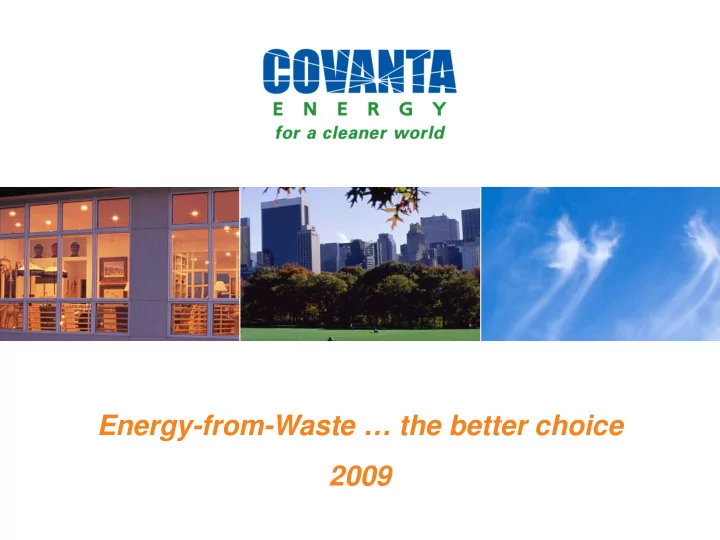

Energy-from-Waste … the better choice 2009
Covanta Overview Covanta Holding Corporation is a publicly-traded company on the New York Stock Exchange (symbol: CVA) Year 2008 operating revenues of $1.66 billion Year 2008 operating Cash flow of $403 million Market Cap ($billion) $4.20 $4.20 World’s leading Energy-from- $3.3 $3.3 Waste (EfW) Company $2.2 $2.2 United States, Europe & Asia 37 EfW facilities $0.6 $0.6 $0.1 $0.1 8,000,000 mega-watt hours/year 16 million tons of waste/year 1/1/04 1/1/04 1/1/05 1/1/05 1/1/06 1/1/06 1/1/07 1/1/07 1/1/08 1/1/08 2
Generating Clean Energy from Waste EfW is a specially designed energy generation facility that uses household waste as fuel. Waste is combusted to produce valuable energy and help solve some of society’s big challenges • Population growth Safe, reliable waste disposal • Climate change Reduces greenhouse gas emissions • Dependence on fossil fuels Clean, renewable electricity • Resource management Recover metal for recycling Municipal Solid Waste Power: 560 kWh (MSW): 2000 lbs Metal: 50 lbs Ash: 10% of original volume 3
Typical EfW Facility Layout 4
Global Energy-from-Waste Industry Landfill • Energy-from-Waste is used extensively worldwide Recycling/ Composting – Nearly 800 EfW facilities; ~140 million tons per year (TPY) EfW Germany Average U.K. U.S. Denmark Italy China Sweden Ireland Japan Taiwan Singapore U.S . Western Europe Asia 87 EfW facilities 388 EfW facilities 301 EfW facilities 29 million TPY 62 million TPY 48 million TPY 5
Leader in U.S. Renewable Electricity and Waste Disposal Annual U.S Renewable Generation = Annual U.S Waste Generation = 87,213,000 megawatt hrs 388,000,000 Tons Energy- Solar from-Waste 1% Wind 18% 20% Recycling Landfill 26% 66% Wood & Energy- Geothermal Other from-Waste 17% Biomass 8% 44% Source: US Department of Energy, Energy Information Source: 2004 Joint Study by Biocycle and Earth Administration 2005 Report Engineering Center of Columbia University • Covanta produces almost 10% of America’s non-hydro renewable electricity – enough to power over a million homes • Covanta converts over 5% of the nation’s post-recycled waste into energy 6
Covanta’s Domestic Facilities 7
Environmental Health and Safety Programs • 23 Facilities in OSHA’s elite VPP STAR Program • Environmental Leadership – 23 EPA performance track facilities – First to install mercury control – New patented low NO x technology – Numerous industry, environmental, and community awards • Sustainable Florida Leadership • Michigan Clean Corporate Citizen • Virginia Environmental Excellence 8
Solid Waste Management Hierarchy The US EPA, EU, and others promote a The US EPA and others promote a hierarchy that identifies the following hierarchy that identifies the following actions in descending order of actions in descending order of preference: preference: 1. Source reduction 2. Reuse 3. Recycling or composting 4. Advanced combustion with energy recovery 5. Landfill disposal 9
Commitment to the environment US EPA MACT Limit (%) 100 Demonstrating our 90 ongoing commitment to 80 the environment, our 70 60 EfW facilities operate 50 with average emissions 40 levels far below US EPA 30 permitted limits: 20 10 0 Mercury Cadmium Lead Particulates Hydrochloric Acid Sulfur Dioxide Nitrogen Oxides Nitrogen Oxides w/VLN Dioxins/Furans Carbon Monoxide 10
Environmental Benefits of Energy-from-Waste • Adopting environmentally sustainable waste disposal practices – EfW is the most attractive, sustainable solution for waste disposal after recycling • Generating clean energy from renewable fuels – U.S. Environmental Protection Agency states EfW “produces electricity with less environmental impact than almost any other source” – EfW can be important contributor to overall renewable portfolio – Baseload power – 24 hours a day, 7 days a week • Reducing greenhouse gas emissions to combat global warming Offsets up to one ton of carbon dioxide equivalent for each ton of waste processed: – Reduces need for landfills, which generate methane, a potent greenhouse gas – Reduces dependence on fossil fuel power: one ton of waste ~ ¼ ton of coal – Reduces energy & emissions from raw metal production (ore mining) via metal recovery 11
EfW Regulatory & Policy Landscape United States • Recognized as renewable in 23 states • Federal legislation – outcome uncertain – Renewable electricity tax credits & Renewable Portfolio Standard (RPS) – Climate Change Europe • EU Landfill Directive – – 65% reduction in landfilling of biodegradable Municipal Solid Waste – Significant Landfill taxes & other incentives to recycle and recover energy • Not subject to CO2 emission caps China • Preferential feed-in electricity tariff • Target 30% EfW by 2030 12
Global Growth Opportunity in Energy-from-Waste Worldwide one billion tons of waste buried in landfills EfW Opportunity • • U.S. and Canada – EfW re-emerging with higher fossil fuel prices and diminishing landfill space – Increasing demand for renewable power generation – Growing attention on Climate Change • Europe – EU Landfill Directive – significant impact on the U.K. in particular – Increasing demand for renewable power generation – Significant focus on Climate Change • China – Growing middle class and urbanization – increasing waste generation – Land at a premium, making landfills less attractive – Increasing demand for renewable power generation 13
14
Recommend
More recommend